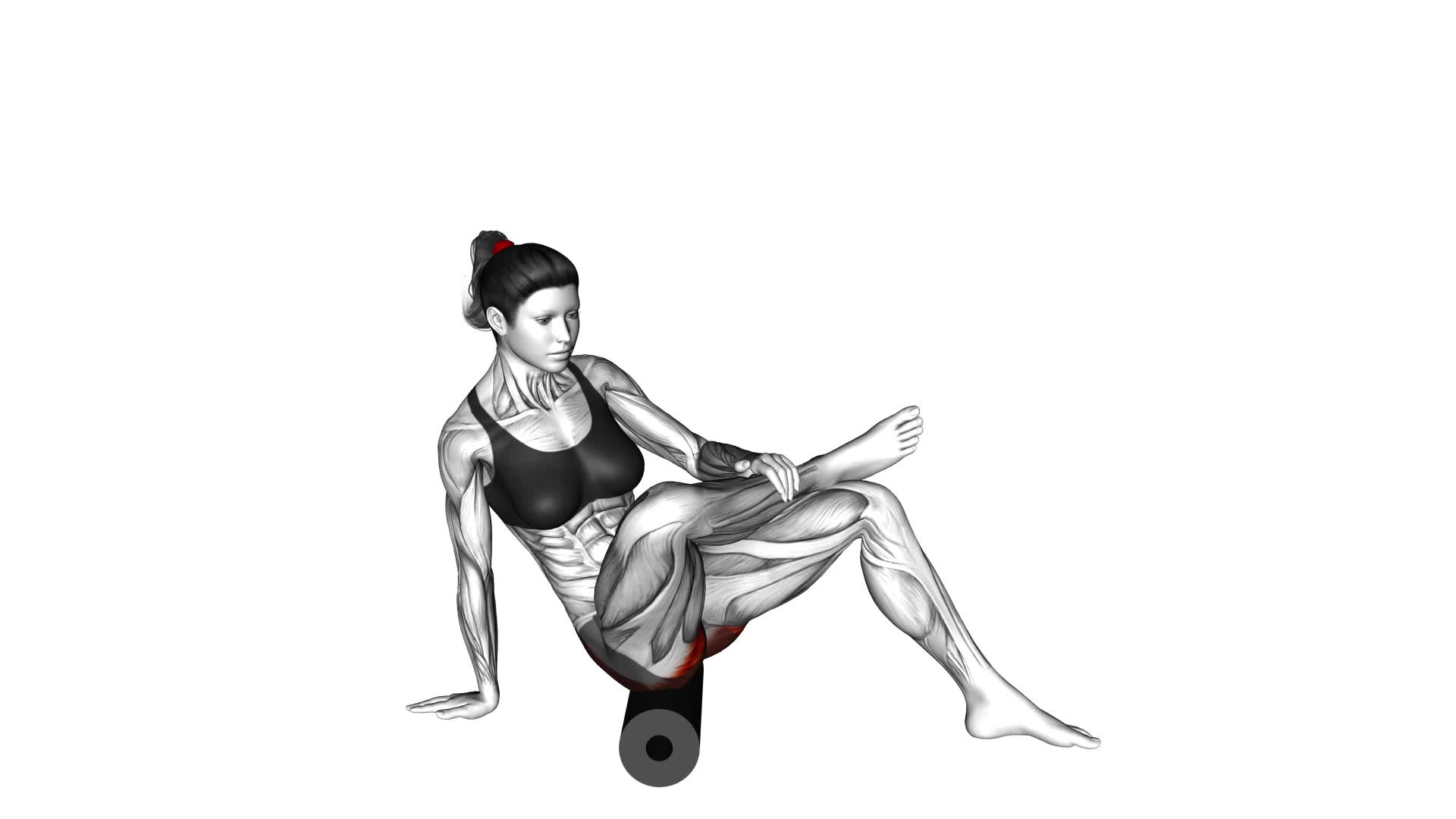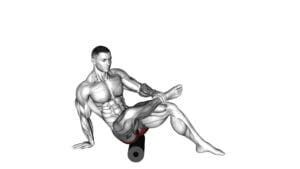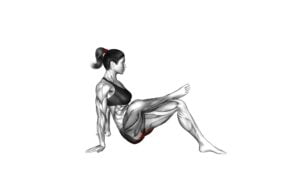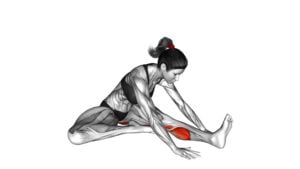Roll Recumbent Hip External Rotator and Hip Extensor Stretch (CrossedLeg) (female) – Video Exercise Guide & Tips

Are you looking for a way to improve your hip flexibility and strengthen your hip muscles? Then the Roll Recumbent Hip External Rotator and Hip Extensor Stretch is perfect for you!
Watch This Exercise Video
This exercise targets your hip external rotators and extensors, helping to increase your range of motion and prevent injuries.
In this video exercise guide, you'll find step-by-step instructions and useful tips to ensure proper form and technique.
Get ready to take your hip mobility to the next level!
Key Takeaways
- Increased flexibility in hip external rotators.
- Improved muscle strength in hip extensors.
- Reduced risk of injuries.
- Customizable variations for specific needs and goals.
Benefits of the Roll Recumbent Hip External Rotator and Hip Extensor Stretch
You will experience increased flexibility and improved muscle strength in your hip external rotators and hip extensors through the Roll Recumbent Hip External Rotator and Hip Extensor Stretch. This stretch targets the muscles responsible for rotating your hips externally and extending them. By regularly performing this exercise, you can enjoy several benefits.
One of the main benefits of the Roll Recumbent Hip External Rotator and Hip Extensor Stretch is increased flexibility in your hip external rotators. These muscles, such as the piriformis and gemellus superior, play a crucial role in hip rotation. When these muscles are tight or stiff, it can limit your range of motion and lead to discomfort. By stretching and lengthening these muscles, you can improve your hip mobility and reduce the risk of injuries.
In addition to increased flexibility, this stretch also helps to improve muscle strength in your hip extensors. The hip extensors, including the gluteus maximus and hamstring muscles, are responsible for extending your hip joint. Strengthening these muscles can enhance your overall lower body power, stability, and performance in various physical activities.
Variations of the Roll Recumbent Hip External Rotator and Hip Extensor Stretch can be implemented to target specific areas of the hip and to accommodate individuals with different flexibility levels. This exercise can be modified by adjusting the angle of the leg or using props such as resistance bands or yoga blocks. These variations allow for a customizable approach, ensuring that you can tailor the stretch to meet your specific needs and goals.
Equipment Needed for the Exercise
To properly perform the Roll Recumbent Hip External Rotator and Hip Extensor Stretch, you'll need a few pieces of equipment. First, you'll need an exercise mat or a comfortable surface to lie down on. This will provide support and cushioning for your body during the exercise.
Additionally, you'll need a foam roller. The foam roller should be long enough to support your entire body lengthwise. It should also be firm enough to provide adequate pressure for the stretch, but not too firm that it causes discomfort.
For beginners or individuals who may have difficulty with the full stretch, there are a few modifications that can be made. One option is to use a smaller foam roller or even a rolled-up towel instead. This can provide less intensity and allow for a gentler stretch.
Another modification is to perform the stretch with the legs uncrossed. This can help to decrease the intensity of the stretch on the hip external rotators and hip extensors.
Remember, it's important to listen to your body and modify the exercise as needed. Always start with a comfortable level of intensity and gradually increase as you become more familiar with the stretch.
Proper Form and Technique for the Stretch
To perform the Roll Recumbent Hip External Rotator and Hip Extensor Stretch with proper form and technique, begin by lying on your back with your legs crossed. This stretch targets the hip external rotators and hip extensor muscles, promoting flexibility and mobility in the hips.
To ensure proper alignment, make sure your spine is straight and your shoulders are relaxed. Engage your core muscles by pulling your belly button towards your spine. This will help stabilize your pelvis and prevent excessive strain on your lower back.
To activate the hip external rotators, gently press your top knee away from your body while keeping your bottom leg crossed over. You should feel a stretch in the outer hip of the top leg. Hold this position for about 30 seconds, breathing deeply and allowing the stretch to deepen.
To further activate the hip extensor muscles, gently press your bottom foot into the floor while maintaining the crossed leg position. This will engage the muscles at the back of your hip and thigh. Hold this position for 30 seconds, feeling a stretch in the back of your leg.
Remember to breathe deeply throughout the stretch and avoid any sudden or jerky movements. Gradually increase the intensity of the stretch as your flexibility improves over time.
Practice this stretch regularly to improve hip mobility and prevent tightness in the hip muscles.
Modifications for Beginners or Those With Limited Flexibility
For beginners or individuals with limited flexibility, there are several modifications that can be made to the Roll Recumbent Hip External Rotator and Hip Extensor Stretch. These modifications will allow you to still benefit from this stretch while working within your flexibility limitations. Here are three modifications you can try:
- Use a Prop: If you find it challenging to reach your ankle or foot with your hand, you can use a prop to assist you. Place a yoga block or a rolled-up towel under your knee or thigh to elevate it slightly. This will reduce the range of motion required and make it easier for you to reach your ankle or foot.
- Decrease Range of Motion: If you have limited flexibility in your hips or lower back, you can decrease the range of motion of this stretch. Instead of crossing your leg over your body, keep your leg straight and cross it in front of your body. This will still target the hip external rotators and hip extensors but with a smaller range of motion.
- Perform the Stretch Standing: If performing this stretch on the floor is uncomfortable for you, you can modify it by performing it in a standing position. Stand next to a wall or a sturdy support and cross one leg over the other. Lean slightly towards the support and feel the stretch in your hip and glute muscles.
Common Mistakes to Avoid During the Exercise
To ensure the effectiveness and safety of the Roll Recumbent Hip External Rotator and Hip Extensor Stretch (CrossedLeg) exercise, it's important to avoid common mistakes.
One common mistake is improper form, which can lead to strain or injury. Another mistake to avoid isn't adequately warming up, as this increases the risk of muscle pulls or tears.
Improper Form Dangers
When performing the Roll Recumbent Hip External Rotator and Hip Extensor Stretch (CrossedLeg) exercise, it's important to be aware of the improper form dangers that can arise if you don't use proper technique. Here are the three main risks associated with improper form and inadequate warm-up:
- Increased risk of injury:
Improper form can put excessive strain on the muscles and joints involved in the exercise, leading to injuries such as muscle strains, tendonitis, or even joint dislocation. It's crucial to maintain proper alignment and control throughout the movement to minimize the risk of injury.
- Limited effectiveness:
Improper form can compromise the effectiveness of the exercise, preventing you from fully engaging the targeted muscles. This can hinder your progress and make it harder to achieve your fitness goals.
- Delayed recovery:
Insufficient warm-up can lead to inadequate blood flow and muscle activation, increasing the risk of delayed onset muscle soreness (DOMS) and prolonging the recovery process. A proper warm-up helps prepare the muscles for the exercise and reduces the likelihood of post-workout discomfort.
Inadequate Warm-Up Risks
Make sure to adequately warm up before performing the Roll Recumbent Hip External Rotator and Hip Extensor Stretch (CrossedLeg) exercise to avoid the risks associated with inadequate warm-up. Inadequate warm-up can lead to various risks and injuries.
It's important to understand the importance of proper warm-up techniques to prepare your body for exercise. A proper warm-up increases blood flow to the muscles, raises your body temperature, and improves flexibility and joint mobility.
Failing to warm up adequately can result in muscle strains, sprains, and even more serious injuries such as muscle tears or joint dislocation. Additionally, inadequate warm-up can lead to decreased performance, as your muscles may not be ready for the demands of the exercise.
Take the time to properly warm up before engaging in any exercise to reduce the risks and ensure optimal performance.
Tips for Maximizing the Effectiveness of the Stretch
To maximize the effectiveness of the Roll Recumbent Hip External Rotator and Hip Extensor Stretch, there are a few key points to keep in mind.
First, ensure proper body positioning by lying on your back with your legs crossed and the foam roller placed under your hip.
Additionally, focus on your breathing techniques, inhaling deeply as you roll the foam roller along your hip and exhaling as you release the stretch.
Proper Body Positioning
To maximize the effectiveness of the stretch, ensure you maintain a stable and aligned body position throughout the exercise. Proper body positioning is crucial for improving flexibility and preventing muscle imbalances.
Here are three essential tips to help you achieve the correct body position:
- Lie down on your back with your legs extended. Keep your spine neutral and avoid arching your lower back. This ensures that the stretch targets the correct muscles and reduces the risk of strain.
- Engage your core muscles by gently drawing your belly button towards your spine. This stabilizes your pelvis and maintains a proper alignment throughout the exercise.
- Relax your upper body and shoulders. Avoid tensing or hunching your shoulders, as this can interfere with the stretch and limit its effectiveness.
Breathing Techniques
To maximize the effectiveness of the stretch and enhance your flexibility, focus on your breathing technique during the exercise. Proper breathing techniques can help you relax your muscles, increase oxygen flow to your muscles, and promote a deeper stretch.
As you perform the Roll Recumbent Hip External Rotator and Hip Extensor Stretch, remember to inhale deeply through your nose as you prepare for the stretch. As you exhale through your mouth, visualize the tension leaving your body and allow yourself to sink deeper into the stretch.
It's important to maintain a steady and controlled breathing pattern throughout the exercise. If you find it difficult to breathe deeply, consider modifying the stretch by using a prop, such as a yoga block or folded blanket, to support your hips. This modification can help you maintain proper alignment and still receive the benefits of the stretch.
Duration and Frequency
To maximize the effectiveness of the stretch and enhance your flexibility, it's important to consider the duration and frequency of the Roll Recumbent Hip External Rotator and Hip Extensor Stretch. Here are some tips to help you optimize your stretching routine:
- Optimal duration and frequency: Aim to hold the stretch for 30-60 seconds on each side. Perform the stretch 2-3 times a week to allow your muscles to adapt and improve their flexibility.
- Progression and increased intensity: As you become more comfortable with the stretch, you can gradually increase the duration by adding 10-15 seconds to each repetition. Additionally, you can increase the intensity by using a foam roller or a towel to create more pressure on the targeted muscles.
- Listen to your body: Pay attention to any discomfort or pain during the stretch. If you experience any sharp or intense pain, reduce the duration or intensity of the stretch and consult a healthcare professional if necessary.
Frequently Asked Questions
How Often Should I Perform the Roll Recumbent Hip External Rotator and Hip Extensor Stretch?
To optimize your results, it's important to know the optimal frequency for performing the roll recumbent hip external rotator and hip extensor stretch. This stretch is beneficial for improving flexibility and mobility in the hip region.
For best results, aim to perform this stretch at least 2-3 times per week. However, it's important to listen to your body and adjust the frequency based on your individual needs and fitness level.
Can This Stretch Help With Lower Back Pain?
Stretching on a regular basis can bring numerous benefits to your daily routine.
In regards to your question about lower back pain, incorporating the Roll Recumbent Hip External Rotator and Hip Extensor Stretch can be helpful. However, it's important to note that there are other stretches that can also alleviate lower back pain.
Some options include the Cat-Camel Stretch, Child's Pose, and the Cobra Stretch.
Remember to consult with a professional before starting any exercise routine to ensure safety and effectiveness.
Is It Safe to Perform This Stretch if I Have a Knee Injury?
If you have a knee injury, it's important to take precautions and modify this stretch to avoid further discomfort or injury. Make sure to listen to your body and stop if you feel any pain in your knee.
You can try using props like pillows or bolsters to support your knee and reduce strain.
It's always a good idea to consult with a healthcare professional or a physical therapist for specific modifications and guidance tailored to your condition.
How Long Should I Hold the Stretch For?
To maximize the benefits of holding a stretch for longer, you may wonder how long you should hold it. The duration depends on various factors, such as your flexibility level and specific goals.
Generally, holding a stretch for 15-30 seconds is recommended for improving flexibility, while longer durations of 60 seconds or more can enhance muscle relaxation and promote flexibility gains.
Remember to listen to your body and adjust the duration accordingly. Consider changing your stretching routine every 4-6 weeks to prevent plateaus and continue making progress.
Can This Stretch Be Done Before or After a Workout?
Stretching before or after a workout has its pros and cons. Incorporating stretching into your routine can provide numerous benefits. Before a workout, stretching can help increase flexibility and range of motion, reducing the risk of injury. However, some studies suggest that stretching before a workout may temporarily decrease muscle strength and power.
On the other hand, stretching after a workout can help with muscle recovery and reduce muscle soreness. It's important to find what works best for you and consult with a fitness professional.
Conclusion
In conclusion, the roll recumbent hip external rotator and hip extensor stretch is a beneficial exercise for improving hip flexibility and mobility. By properly engaging the hip muscles and using the correct form and technique, individuals can effectively stretch and strengthen these areas.
Beginners or those with limited flexibility can modify the exercise to suit their needs, while avoiding common mistakes. By following these tips and guidelines, individuals can maximize the effectiveness of the stretch and achieve optimal results.

Author
Years ago, the spark of my life’s passion ignited in my mind the moment I stepped into the local gym for the first time. The inaugural bead of perspiration, the initial endeavor, the very first surge of endorphins, and a sense of pride that washed over me post-workout marked the beginning of my deep-seated interest in strength sports, fitness, and sports nutrition. This very curiosity blossomed rapidly into a profound fascination, propelling me to earn a Master’s degree in Physical Education from the Academy of Physical Education in Krakow, followed by a Sports Manager diploma from the Jagiellonian University. My journey of growth led me to gain more specialized qualifications, such as being a certified personal trainer with a focus on sports dietetics, a lifeguard, and an instructor for wellness and corrective gymnastics. Theoretical knowledge paired seamlessly with practical experience, reinforcing my belief that the transformation of individuals under my guidance was also a reflection of my personal growth. This belief holds true even today. Each day, I strive to push the boundaries and explore new realms. These realms gently elevate me to greater heights. The unique combination of passion for my field and the continuous quest for growth fuels my drive to break new ground.







